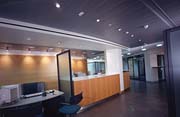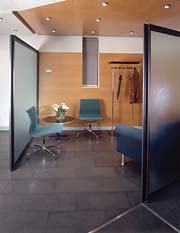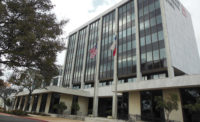

According to Project Architect Peter Papadatos of Papadatos Partnership LLP, the overall goal of the project was to create a long-lasting building with a solid image. He considered using porcelain tiles for the bank; however, budget allowed for the use of a more elegant stone, which is why he chose Basaltina, a grayish volcanic stone from Italy. “I first came across Basaltina in Bern, Switzerland, during a renovation of my local bank, UBS (Union Bank of Switzerland),†said Papadatos. “I contacted the local architect regarding the stone that was being installed, and he directed me to the local stone supplier. The stone had a remarkable ability to keep a clean appearance, even in the snow and salt in Bern.â€
More than 3,000 square feet of lava stone -- quarried in Latium, a province of Rome -- was supplied by Conti & Conti from Russia, and some specially coordinated pieces were used for the counters and windows. Papadatos felt that the durability of the volcanic stone would be a good asset to the Garanti Bank project, since Moscow has such harsh weather conditions. “This is due in part to the climate, the constant construction in the city which creates much dust, the sand and salt that is spread during the winter months from November to April, and the poor maintenance of most properties,†he said. “Typical floor maintenance is handled by a [worker] with a bucket full of dirty water and a dirty mop, spreading the dirt and grime all over instead of cleaning.†He added that this lackadaisical process occurs because of cultural reasons, budgets and the lack of qualified cleaning maintenance companies.
The Basaltina stone was honed and treated with a silicone impregnator, which makes the stone easier to clean. “In Russia, they refer to honed as a matte finish, which means that the stone is not rough or polished; it is really smooth,†said Papadatos. Type A Italian Bianco Carrara marble was used for the countertops, transaction counters and windowsills in the bank, while a grayish Type C Carrara was used for the wall bases. According to Papadatos, the 2-inch-thick marble slabs were chosen for their elegance, and because they went well with the light woodwork featured throughout the bank.
Papadatos explained that many aspects of the project were a challenge. “We built everything to our specifications -- everything but the furniture was designed by us,†he said. Papadatos' crew also faced hardships when their original supplier fell through, and because they had so many different people from various countries working on the project. “We had a Spanish project manager, a Cuban site manager, I am living in Switzerland, and we were working on a Turkish bank,†he said. “We must have had a mix of at least 10 different countries working on the project, including Italy, Spain, Cuba, Finland, England, Russia, Sweden and the U.S. If anything, it was a very multi-national project. Luckily, the language used and understood by all was English.â€
When the crew began construction, a small branch of the bank was already in existence. “It was like working on two separate projects. First, we redesigned the existing bank, then we tore down the wall and constructed the other side,†said Papadatos, who said that the most difficult task was fusing the two parts together. “We had to match the two floors perfectly, and blend them together,†he added. Overall, construction lasted for approximately seven months. Installation of the stone was completed with six installers and one foreman, according to Project Manager Emilio Alvarez of Skanska Olson, and the stonework on the project took approximately five weeks to finish.
Looking back on the project, Papadatos joked that when his wife visited Moscow, she expressed to the President/CEO of Garanti Bank, Murat Agabeyoglu, that her husband had not taken her to see the historic Moscow Kremlin. His response was,†…but he took you to the Kremlin of all banks.â€
This past year, the New York Council-Society of American Registered Architects, awarded Papadatos Partnership LLP with an award for Special Recognition for Design Excellence 2004, in regards to Garanti Bank.

End box
Garanti BankMoscow, Russia
Architect: Papadatos Partnership LLP, Switzerland
Stone Installer: Skanska Olson, Russia
Stone Supplier: Conti and Conti, Russia
